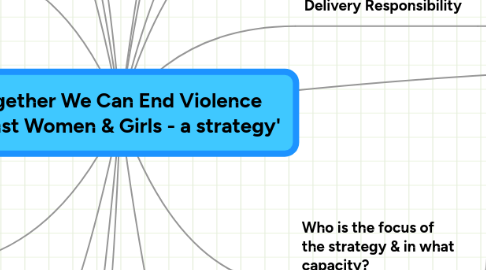
1. Key Areas
1.1. 1 - PREVENTION; changing attitudes & preventing violence
1.2. 2 - PROVISION; helping women & girls continue with their lives
1.3. 3 - PROTECTION; delivering an effective CJS
2. Previous strategy; serious violent crime agenda
2.1. 'Saving Lives, Reducing Harm, Protecting the Public: An action plan for the tackling of violence 2008-11'
2.1.1. 'Cutting Crime: A New Partnership 2008-11'
2.1.2. Strategic Plan for Reducing Reoffending 2008-11'
2.1.3. Criminal Justice Strategic Plan 2008-11: working together to cut crime & deliver justice
3. Voluntary Sector relationships
3.1. Voluntary Sector as delivers of strategy
3.2. Voluntary sector as 'partners' in developing policy, e.g. EVAW
3.3. Voluntary sector as challengers of official policy / active agents in alternative strategies, e.g. Truth about rape; Million Women Rise; White Ribbon Campaign
4. Defining Term; Violence Against Women and Girls. Draws almost exclusively on the UN Human Rights framing; note the disparity between the explicit defining of VAWGs using UN HRs agendas and the missing HRs frame as guiding principles throughout the rest of the strategy, e.g. no explicit recognition of a link between VAWGs and gender equality. Additionally, VAWGs is defined as an 'enduring social problem'
4.1. UN Declaration on the Elimination of VAW; 'any act of gender-based violence that results in, or is likely to result in physical, sexual or psychological harm or suffering
4.2. UN Convention on the Elimination of all forms of discrimination against women; 'violence directed at a woman, because she is a woman or acts of violence which are suffered disproportionately by women'
4.3. European Convention on Human Rights
4.4. The Platform for Action
4.5. Women 2000
4.6. Beijing +10 Regional Conference
4.7. UN Security Counsel Resolutions 1820, 1888 & 1325
4.8. Convention on the Rights of the Child
4.9. What does the move from defining the 'different' types of violence individually (e.g. domestic violence, sexual assault, rape etc) to an encompassing term 'VAWGs' mean, who uses it and in what context?
4.9.1. Government
4.9.2. Practitioners
4.9.3. Campaigners
4.9.4. The public
5. ACCOUNTABILITY; the strategy is cross-government and cross-hierarchical in terms of national and local government. However, it also makes clear that responsibility for delivery is local, with national government in a facilitation role.
5.1. Single inter-ministerial group
5.1.1. Cross-department delivery board, managed by the Home Office and reporting to the inter-ministerial group
5.2. Annual independent review of progress
5.3. Annual parliamentary debate
6. Comparison with other strategies aiming to tackle 'violence'
6.1. Hate Crime
6.2. Gang violence
6.3. Street violence
6.4. Youth violence
6.5. Child abuse
7. Popular discourses on VAWGs
7.1. HO attitudes survey show little sympathy for victims of violence
7.2. Need to investigate other sources of 'attitudinal' evidence on VAWGs
7.2.1. Nicholson & Wilson, (2004); 'Is Domestic Violence a Gender Issue? Views from a British City', in Journal of Community & Applied Social Psychology, 14, pp.266-283
8. Who was influential in the shaping of this strategy?
9. In What theoretical perspectives can be utilised in policy analysis?
10. Evidence Based Policy? / Does the strategy conform to neoliberal / managerial 'evidence' based problem-solving approaches as opposed to political driven change?
10.1. What evidence is used?
10.1.1. British Crime Survey; 'victim' based evidence used to support the claims that women are victims of particular types of violence, i.e. domestic violence & sexual assault.
10.1.1.1. data available
10.1.2. 'Together We Can End Violence Against Women & Girls' consultation; including evidence from victims of violence, frontline staff and public
10.1.2.1. data requested
10.1.3. Sara Paynes' Victims Experience Review
10.1.4. HO Survey on public attitudes towards VAWGs, Feb 2009
10.1.4.1. data requested
10.1.5. NSPCC & University of Bristol 'Partner Exploitation & Violence in Teenage Intimate Partner Relationships'
10.1.5.1. data requested
10.1.6. Department of Health figures for children witnessing domestic abuse, 2002
10.1.7. CPS 'Violence against women crime report 2007-2008'
10.2. What evidence is in the process of being gathered as part of the strategic agenda?
10.2.1. NHS Health Task Force
10.2.2. Dept for Children, Schools & Families VAWGs Advisory Group
10.2.3. Dr L papadopoulo's report on the sexualisation of young people
10.2.3.1. Due Jan 2010
10.2.4. Robust local data on VAWGs coupled to needs assessments
10.2.5. Investigating the possibility of a national, regional or local dataset
10.2.6. Baroness Stern's review of the responses of the CJS and other agencies to rape complaints
10.2.6.1. Due Mar 2010
10.3. What does the statistical evidence presented say?
10.4. What statistical techniques are used and are they appropriate?
10.4.1. Where modelling is used in the reference source, it is GLMs. QUESTION - if there is an assumption that women are subject to this violence because they are women, is the underlying assumption of independence between individuals in GLMs valid?
10.4.1.1. What are the results if an assumption of dependence is made based on gender? E.g. use multi-level modelling which takes gender as a separate level to other characteristics?
10.4.2. There is no description of statistical techniques utilised to produce the evidence cited, rather, all the evidence comes from secondary sources, which present the results of analysed data.
10.5. What evidence is missing / not invoked?
10.5.1. Women as victims of other types of violence, e.g. BCS figures on physical assaults by a stanger
10.5.2. Men as victims of this type of violence
10.5.3. The perpetrators of violence
10.5.4. victims of these types of violence within same sex relationships
10.5.5. Female non-victims
10.6. What about 'evidence' which cannot be measured / cannot be measured using the current 'managerial' framework? For example the comparisons made with co-production by NEF in 'The Challenge of Co-Production'
10.6.1. data missing not at random
